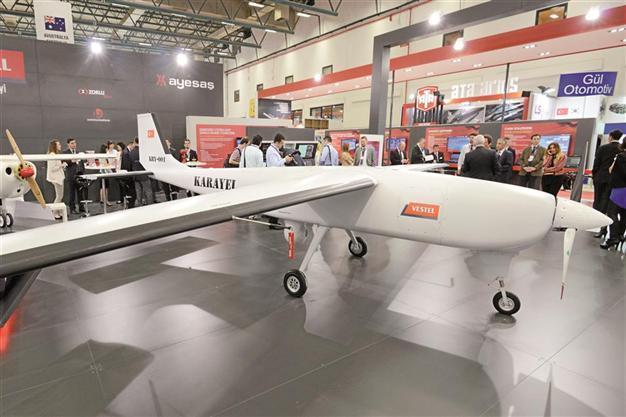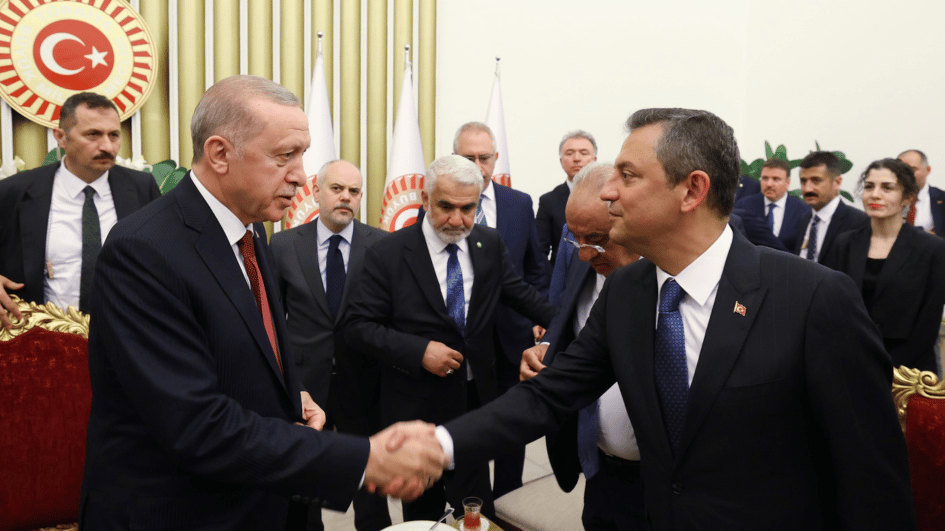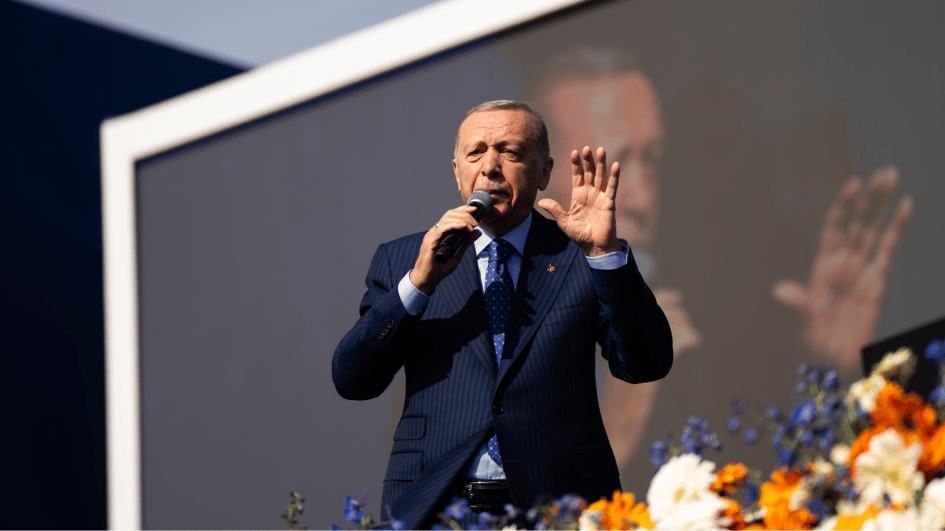Booming Turkish arms sector puts mark on fair
Burak BEKDİL ANKARA - Hürriyet Daily News

The Zorlu Group unveils its tactical unmanned aerial vehicles, which were produced for the Turkish army, at the International Defense Industry Fair. DAILY NEWS photo, Emrah GÜREL
For several years in a row, Turkey’s premier defense exhibition IDEF was a venue for Western weapons makers to showcase their products primarily aiming at Turkish buyers willing to shell out the big bucks. Not anymore. This year, the show has opened with Turkish arms makers predominantly showcasing their products to potential buyers from both home and abroad.“The rational corporate strategy for the foreign company is no longer to ‘market,’ but to explore opportunities to ‘develop’ with a Turkish partner and sell either to Turkey, to third countries or both,” said a top defense procurement official.
A London-based defense analyst agrees: “It is true that along with Turkey’s local defense industry, the ethos for IDEF has metamorphosed.”
IDEF’13 will host over 800 defense companies from 49 countries from May 7 to 10 in Istanbul. Organized since 1993, the exhibition is viewed as one of the world’s top five international events on defense and security. Turkish Defense Minister İsmet Yılmaz has said he expects a “record number of agreements to be signed during the exhibition.”
Over the last several years, Turkey has made it an “established government policy” to seek local solutions to meet the modernization needs of NATO’s second largest army. “I guess we have been too explicit in our emphasis on local solutions and our desire to go as national as possible,” the defense procurement official said. “I do not think any smart manufacturer could view Turkey as a market now.”
In recent months, Turkey’s defense companies have given pace to their efforts to unveil several “national Turkish” systems apparently in efforts to showcase them at IDEF’13.
In March, Turkey’s biggest defense company, Aselsan, announced that it had successfully developed the country’s first indigenous identification friend or foe (IFF) system and delivered the first prototypes to the Turkish military. Two prototype systems had been delivered to the Armed Forces in February and marked a “first time achievement” for Turkey’s thriving local industry.
“This puts Turkey onto a small list of seven countries that have the capabilities to manufacture IFF systems,” said Cengiz Ergeneman, Aselsan’s CEO.
Aselsan had signed a contract with Turkey’s Defense Ministry in December 2006 to design, develop and manufacture the prototypes. The company now awaits a fresh contract with the country’s procurement agency, the Undersecretariat for Defense Industries (SSM), for serial production.
The prototypes developed by Aselsan successfully passed a final round of performance tests last November. They will be initially outfitted into Turkey’s F-4 aircraft and air defense radars and, at later stages, into other aerial and naval platforms, except the F-16 fighter jets.
“The system is entirely indigenous and marks a first time for the Turkish industry,” said an Ankara-based defense analyst. “This is certainly a big leap forward in Turkish military electronics.”
A procurement official familiar with the program said the production contract would involve scores of Aselsan IFF systems and could go up to $100 million initially, going beyond that number in years to come as more and more Turkish platforms queue up to be outfitted.
The IFF is an identification system designed for command and control. It enables military and national interrogation systems to identify aircraft, vehicles or forces as friendly and to determine their bearing and range from the interrogator. IFF may be used by both military and civilian aircraft. The major military benefits of IFF include preventing “friendly fire” and being able to positively identify friendly forces.
In an IFF system, Modes 1, 2, 4 and 5 are for military use only. Modes 1, 2 and 3/A are collectively known as Selective Identification Feature (SIF) modes. Civilian aircraft use modes 3/A, C and S. Mode C, which includes barometric pressure altitude information, is often used in conjunction with mode 3/A. Mode S is a new civilian mode developed to replace both mode 3/A and C.
Aselsan has developed and produced two IFF prototypes for the Turkish military, both of which are for medium-range coverage. Its transponder IFF systems are to be outfitted to naval and aerial military assets, and the interrogator IFF systems for air defense radars. Aselsan’s transponder systems cover modes 1, 2, 3/A, C, 4 and 5 and are compatible with NATO’s STANAG 4193 which defines the alliance’s fundamental technical requirements for IFF systems.
Aselsan’s two major local subcontractors for the prototype outfitted into an F-4/E 2020 aircraft were privately-owned electronics and telecom concern Netaş Telekomunikasyon A.Ş. and Bilgem, an information technologies and advanced technological research center of the Turkey’s state scientific research institute TÜBİTAK.
Aselsan’s market value was at $1 billion in 2011, according to independent auditors. It has backlog orders worth $4.3 billion until the year 2018.
Earlier this year, Aselsan, along with Netaş and Argela, a software company, signed a $46.8 million contract with the Turkish government to build fourth-generation mobile phone software and equipment. The new system for civilian and military use will be capable of delivering speeds of 100 megabits per second for mobile and 1,000 Mbps for fixed-line telecommunication. Speeds for current third-generation mobile systems average 10 Mbps and can occasionally reach 40 Mbps.
Another indigenously developed Turkish weapon is an anti-tank missile, the UMTAS, revealed last month. “After years of going from one foreign supplier to another, we are happy to have our companies providing us with national solutions,” a senior army official said.
Procurement officials said the UMTAS had recently undergone several successful field tests. “This system can quickly find foreign buyers and mark an impressive transformation [of Turkey] from an import-dependent country into an exporting one,” one procurement official said. “It is relatively low-cost and reliable.”
State-owned missile maker Roketsan initiated the long-range anti-tank UMTAS missile project in efforts, first, to meet local demand from the Turkish Armed Forces, and later to export it, especially to countries in the region. The UMTAS, with its infrared imaging and laser-seeker options, is an anti-tank missile with a range of eight kilometers to be used in air-to-ground and ground-to-ground operations.
Roketsan officials said the system is going through further tests for technical properties and compatibility with environmental conditions. Thus far, the system has completed ballistic-missile tests and controlled-missile tests, and its sub-system design has been finished, they said.
The UMTAS is considered the official anti-tank system for the T-129, the helicopter gunship Turkish Aerospace Industries (TAI) is co-producing with Italian-British AgustaWestland in a $3.2 billion project. It also can be integrated into the Anka, Turkey’s first locally developed unmanned aircraft. Other potential platforms to be outfitted with the UMTAS are armored land vehicles and naval vessels.
Meanwhile, an indigenous basic trainer aircraft which Turkey designed and has been developing is going through a final round of tests before it makes its maiden flight in June.
Turkish Aerospace Industries (TAI) is manufacturing four prototypes of the Hürkuş for an entire round of tests. The first prototype successfully went through engine tests in February; the second is being tested for static durability and cabin pressure; the third currently is being assembled and; the fourth will be tested for metal fatigue. A total of 220 aviation experts are supporting the certification work for the European Aviation Safety Agency (EASA) CS 23 standards.
The Hürkuş will be a trainer with a lifespan of 10,500 flight hours, or a 35-year service life. It’s a two-seater turboprop aircraft with a 1,600 hp engine (PT6A-68T), which can fly at an altitude of 10,577 meters at a maximum speed of 574 km per hour. Aviation experts say that success on the Hürkuş will be a landmark achievement for the Turkish industry and reduce dependence on foreign acquisitions. It is particularly important that the Hürkuş comes after the first Turkish-made drone, the Anka, also developed by TAI.
The Hürkuş will be equipped for day and night flying as well as basic pilot training, instrument flying, navigation training, weapons and formation training. The aircraft will have good visibility from both cockpits with a 50 degree down-view angle from the rear cockpit, cabin pressurization (nominal 4.16 psid), Martin-Baker Mk T-16 N 0/0 ejection seats, an on-board oxygen generation system (OBOGS), an Environmental Control System (Vapor Cycle Cooling), an anti-G system, high shock absorbing landing gear for training missions, and Hands On Throttle and Stick (HOTAS). Microtecnica of Turin has been selected to provide the aircraft’s environmental control system.
The Turkish government has indicated that the aircraft is expected to attract export sales, possibly from Arab countries or countries with limited air force budgets.
The Hürkuş will come in four variants.
The Hürkuş-A: Basic version which has been certified with EASA according to CS-23 requirements. It is intended for the civilian market.
Hürkuş-B: Advanced version with integrated avionics including a mission computer, and cockpit avionics layout similar to F-16 and F-35 fighters. The Turkish Army is considering an initial order for 15 aircraft.
Hürkuş-C: An armed version for the close-air support role will have a maximum weapons load of 3,300 pounds. The Turkish army has expressed interest in the Hürkuş C to provide support for its attack helicopters.
Coast Guard version: TAI plans to offer another version of the Hürkuş to support the Turkish Coast Guard’s maritime patrol activities. The aircraft’s back seat would be occupied by an operator for a FLIR sensor.
Armoured tactical vehicle on the way
And most recently, Turkey’s leading armored vehicles manufacturer, Otokar, has revealed what it views as the most strategic indigenous vehicle ever developed by a local company, a tracked armored tactical vehicle, the Tulpar. Analysts say that once the Tulpar has hit serial production line, it would end Turkey’s dependence on imported tracked vehicles. But they also say the Tulpar may have to find export markets rather than winning huge domestic orders.
“The Tulpar is a vehicle the Turkish military needed in large quantities. But the current peace process with Kurdish insurgents will probably mean less local demand than potentially foreign demand for a vehicle like this,” said the London-based analyst.
After a three-decade-long civil strife with its autonomy-seeking Kurdish minority and nearly 40,000 deaths, the Turkish government earlier this year launched ambitious peace talks with militant Kurds. The Kurdish separatist Kurdistan Workers’ Party (PKK) promised to withdraw from Turkish territory as of May 8 in return for broader political rights and constitutional recognition. Turkey, the U.S. and the European Union recognize the PKK as a terrorist entity.
“The Tulpar is a strategic product for the Turkish military. It is designed to fight all anti-tank assets along with the new generation tanks Turkey will possess,” Serdar Görgüç, general manager for Otokar, told reporters.
The Tulpar boasts an advanced ballistic and mine resistant body and modular armor technology. It can carry an entire infantry squad.
Otokar unveiled last year the country’s first national main battle tank, the Altay, with top government officials promising that the program will be completed “one or two years” ahead of time.
In 2008, Otokar signed a $500 million contract with the country’s procurement office, the Undersecretariat for Defense Industries. Under the deal, Otokar will finish building four prototypes of the Altay this year, two years ahead of the original schedule. The four prototypes will undergo performance test throughout 2013.
The SSM selected South Korea’s Hyundai Rotem for the overall technical support. Turkey’s Aselsan was chosen as the Fire Control System and Command, Control and Communications Information system subcontractor. Also the state-owned MKEK was selected as the subcontractor for the 120 mm primary weapon and Roketsan was tasked with the job to provide the armor.
Procurement officials said the serial-production agreement for the Altay would be effective probably in 2017, and together with the expected foreign orders, a first batch of at least 200 tanks is expected to be produced. The Altay probably will be the world’s most modern tank in the 60-ton tanks category by then.
Otokar also produces several other armored vehicles, the most known of which is Cobra, a 4X4 vehicle, used for reconnaissance and area control purposes by the Turkish security forces and the armies of several other countries. Together with the Tulpar and the Ural, Otokar also has launched the Cobra II, an advanced version of the Cobra. Otokar also manufactures the Arma 6X6 and the Arma 8X8.
The Tulpar is Otokar’s second tracked vehicle after the Altay.
















